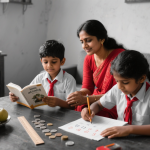- December 12, 2023
- by Educational Initiatives
- Blog
- 0 Comments
Sports day was nearing and the practice sessions had begun. Aaron and Vatsal best buddies were the most popular competitors in the class when it came to sports. Both of them participated in at least three to four different events. Their favourite event was the long jump. Maahir, the third one in the group, being the most meticulous observer, always wanted to be the judge and noted down the timings and distances during their practice sessions.
Aaron and Vatsal used to take turns to jump and then come running to Maahir, who would have done the job of not just seeing who jumped farther, but even noting down the exact distance jumped. He actually used a measuring tape to measure the distance. After one such attempt, they came to Maahir and asked him who the winner was. Maahir: “Aaron, you jumped 2.155 metres and Vatsal, you jumped 2.17 metres. And so Aaron, I think you are the winner.”
Vatsal was disappointed to hear this, since it was the third time in a row that he had lost. But Aaron didn’t seem too happy about his victory. In fact, he was surprised. And so was Maahir. He still kept checking his record book. He thought he had seen Vatsal covering a longer distance than Aaron.
Maahir: “Aaron and Vatsal, wait. I think we are making some mistake.”
Aaron: “Maahir, don’t you think Vatsal is the winner? I saw him crossing my mark.”
Vatsal: “How can that be possible? Don’t you see the readings? I trust Maahir. He must have taken the readings very carefully. And since 2.155 is more than 2.17, you are the winner.”
Aaron: “How can you say that 2.155 is more than 2.17?” Vatsal: “Of course 2.17 is bigger than 2.155. What do you say, Maahir?”
Maahir: “I think Vatsal is correct. But I am slightly confused.”
Aaron: “I don’t think both of you are correct. Let’s go to Swara teacher and ask her what she thinks.”
And the three of them ran to the staffroom. Swara, their Maths teacher, had covered the unit on decimals a month ago. As Aaron and Vatsal presented their confusion to her, a smile grew on her face. She knew the error they were making.
Swara: “So Vatsal, tell me why you think 2.155 is bigger than 2.17. And then we will hear what confusion Maahir has.”
Vatsal: “That is simple. 2.155 is bigger than 2.17 because the digit before the decimal point is the same in both the numbers. So we need not compare it. We need to check the number after the decimal point. Since 155 is bigger than 17, 2.155 is bigger than 2.17.”
Swara: “Maahir, do you agree with Vatsal? What are you confused about?”
Maahir: “I think Vatsal is correct. I have a slightly different reason. I thought 2.155 is bigger than 2.17 because there are more digits after the decimal point in 2.155 and less in 2.17. But I am confused because I saw Vatsal jumping farther than Aaron and so, that should mean that 2.17 is bigger than 2.155.”
By this time, Swara realised that she would have to go back to the class and check how many more students thought the way Vatsal did. The question shown in Figure 1 was asked to around 10,000 students of Class 6 across India.
 |
| Figure 1: The decimal question. |
Demystifying decimals
As seen above, Aaron, Vatsal and Maahir were totally confused by the decimals. In the long jump activity, they saw Vatsal jumping beyond Aaron’s mark, but because of their incorrect understanding of decimals, they thought that Aaron was the winner. When they presented their doubts to their teacher, Swara, she realised the mistake they were making and thought of going back to her class to check how many more students were making similar mistakes. Figure 2 shows the question that was asked to around 10,000 students of class 6 across India. The graph shows the results.
 |
| Figure 2: The decimal question |
 |
| Figure 3: Graph representing the students’ response |
63.5% of the students think that the answer is A, 6.3. Whereas the actual answer is D, since all the given numbers are less than 6.5. So what could be the error that the students selecting option A are making? Why do they think that only 6.3 is less than 6.5? Let’s go back to Swara’s class and see the kind of responses that students gave to this question.
Swara: “Aaron, Vatsal, Maahir and I have had an interesting discussion and we want to know your opinion, too. We have a doubt regarding a decimal question. Let’s look at the question.”
She showed the question shown above to her class. Swara: “So Aaron, what do you think is the answer and why?”
Aaron: “I think it’s option A because only 63 is less than 65. The other two numbers, 647 and 6393 are bigger than 65.”
Swara: “And what’s your answer, Vatsal?”
Vatsal: “Even I think the answer is option A because if we compare the numbers – 47 and 393 are bigger than 5, whereas only 3 is less than 5 and so only 6.3 is less than 6.5.”
Swara: “Is there anyone who thinks the answer is option A but has a reason different from what Aaron and Vatsal said?”
Another student in the class, Shaili, wanted to add her views. Shaili: “I think the answer is option A because there are more digits in 6.47 and 6.393 than 6.5 and so they cannot be less than 6.5.”
It was pretty clear from the responses given by the students that they were considering decimals to be just like whole numbers, and comparing them in the same way.
They were familiar with whole numbers and concepts related to them. And they were extending the same reasoning to decimal numbers.
This is not surprising at all. Students spend almost five to six years learning whole numbers, operations on whole numbers, place value, etc. And so, it becomes hard to make a shift from the whole number system to the decimal number system. When given the numbers 65 and 647, they know that 647 is bigger than 65. But, a comparison of the numbers 6.5 and 6.47, requires the understanding that 6.5 means 6 ones and 5 tenths whereas 6.47 means 6 ones, 4 tenths and 7 hundredths. And so 6.47 will be less than 6.5. This might be difficult to understand if taught by the talk and chalk method. But there are ways to help students understand this concept.
One such method is using physical objects, like the base – 10 blocks (shown below in Figure 4).
 |
| Figure 4: Base-10 blocks. |
Let them manipulate the blocks and see that just as ten ‘1’blocks make 10 and ten ‘10’blocks make 100, similarly, ten ‘0.1’blocks make 1 and ten ‘0.01’blocks make 0.1.
This will help them see which number is smaller and which is bigger and the way they are related. Ask students to try to make the numbers given in the question using such blocks and check which numbers are less than 6.5.



